Erythema nodosum or Knot rose is an inflammatory skin disease that leads to soft, lumpy and painful inflammatory reactions in the subcutaneous fatty tissue. The nodular rose occurs on the front of the lower legs. Women are mainly affected by erythema nodosum. A nodular rose is often mistaken for a nodular rose by doctors due to similar complaints and symptoms and treated incorrectly.
What is erythema nodosum?
.jpg)
© stockshoppe - stock.adobe.com
In the case of erythema nodosum, several nodular foci of inflammation develop on the lower legs - rarely in other parts of the body such as the buttocks. They can vary in size and, depending on the severity of the knot rose, merge into one another.
The inflammation affects the subcutaneous fatty tissue. The tissue becomes inflamed for various reasons, including allergies, hormone fluctuations or infected injuries in addition to a bacterial infection. Erythema nodosum is a very painful disease, but in many cases it heals spontaneously without any treatment.
What remains initially are skin changes that resemble healing hematomas. It is possible that erythema nodosum could develop into a chronic condition caused by another underlying disease. However, nodular rose also occurs as an isolated disease.
causes
Erythema nodosum has a number of very different causes. At first sight there is inflammation of the skin. In the case of nodular rose, however, the trigger for this ranges from a bacterial infection in a completely different area of the body to an isolated outbreak without any further trigger.
Apart from the isolated nodular rose, it can be assumed that the skin reacts to another impairment of the body through the inflammation. Erythema nodosum is often seen in connection with tonsillitis or intestinal inflammation. An allergic reaction or hormonal fluctuations from taking the contraceptive pill and during pregnancy can also lead to erythema nodosum.
The characterization as an overreaction is supported by the fact that in most cases the nodular rose also heals without problems.
You can find your medication here
➔ Medicines against redness and eczemaSymptoms, ailments & signs
Erythema nodosum is noticeable through the characteristic lumps in the subcutaneous fatty tissue. The growths are very tender on pressure, blurred and can be felt from the outside. They reach a size of several centimeters and can become a larger lump as the disease progresses.
The surrounding tissue is reddened and overheated, when several growths merge it often takes on a dark red color and is very sensitive to pressure. The color of the nodes changes in the course of the disease from a reddish-purple tone to a yellowish-green color. The inflammatory nodules predominantly occur on both lower legs, especially in the area of the shinbones and ankles.
In severe cases, additional knots form on the knees, thighs, arms, and elbows. In addition to the external features, erythema nodosum manifests itself through an increasing feeling of illness. Those affected often feel exhausted and tired, and suffer from fever or joint and muscle pain.
In the later stages, circulatory problems such as sweating or palpitations can occur. If the lumps are scratched open, infection can develop. Thanks to the noticeable signs and symptoms, a nodular rose can be diagnosed quickly and then treated in a targeted manner.
Diagnosis & course
An erythema nodosum is unproblematic in the diagnosis due to its typical lump formation, the reddened skin and the occurrence usually limited to the front of the lower legs.
To clarify another underlying disease, infections such as tonsillitis or intestinal diseases are inquired about and, if in doubt, more precisely determined if the symptoms are unclear. A possible pregnancy should already be clarified because of the drug treatment of the erythema nodosum.
The nodular rose usually develops within a few days and then lasts for a period of two to three weeks. Eventually the symptoms subside and leave behind bruises as a consequence of the skin inflammation. During this time, a patient may feel exhausted and febrile. He tires easily and is less efficient due to the knot rose.
The painful skin changes in erythema nodosum impair the ability to move and generally cause physical and psychological weakness.
Complications
Erythema nodosum, also known as nodular rose, is one of the inflammatory skin diseases that often affect women. Soft knots that are visibly reddened develop in the subcutaneous fatty tissue on the front of the lower leg. If the affected areas swell, they start to hurt badly. The symptom is often confused with the wound rose. Those affected should therefore consult a doctor at the first signs.
The cause of the disease can be a bacterial infection or an isolated outbreak, whereby the skin reacts to an endogenous side effect by means of inflammation. These include intestinal diseases, allergies, hormone fluctuations, oral contraceptives, tonsillitis and pregnancy. In most cases there are few complications, but the symptom can develop chronically if there is another underlying disease or overreaction.
If an erythema nodosum is not treated in time, not only does the triggering cause deteriorate. The extremely pressure-sensitive lumps can swell under the surface of the skin to the size of the palm of the hand and, in addition to severe reddening of the skin, also cause hematomas. The legs hurt, feel overheated, puffy, and heavy.
Some people affected experience attacks of fever and a significant drop in performance. The medical countermeasures allow the nodular rose to subside relatively easily in around three weeks if it is recognized early, and at the same time treat the disease or infection causing it. If the therapy is medication based on cortisone, the existence of a pregnancy should be excluded beforehand.
When should you go to the doctor?
If lumps form on the skin that are felt to be painful or uncomfortable, a doctor should be consulted. If the symptoms persist or if they recur, it is advisable to consult a doctor. If there are inflammatory symptoms, a doctor should also be consulted.
With the formation of pus and the development of open wounds, germs can enter the organism and lead to further diseases. Since there is a risk of blood poisoning in severe cases, a doctor should be consulted as soon as you feel unwell or increase your body temperature. If body fluids leak from the nodes, this is considered unusual and should be clarified.
If the lumps increase in girth and size, a doctor should be contacted. If emotional or psychological problems set in, a doctor is required. Persistent mood swings, depressed mood, or social withdrawal are considered worrying and should be discussed with a doctor. If the person concerned suffers from pain, swelling or joint problems, he needs a doctor.
If the complaints lead to reduced movement or incorrect posture, a doctor's visit is necessary. There is a risk of permanent damage, which should be prevented in good time. If you feel permanent warmth in the affected areas, it is advisable to consult a doctor.
Doctors & therapists in your area
Treatment & Therapy
Treatment is not absolutely necessary for erythema nodosum, but should be done because of the considerable pain. Erythema nodosum usually responds well to anti-inflammatory drugs.
The external application of a cortisone-containing ointment is helpful for faster healing of the skin changes. Oral administration of cortisone preparations can also shorten the course of the disease. Antibiotics are used when the underlying disease is a bacterial infection such as tonsillitis. If it heals, the nodular rose also improves in direct connection.
Since the lower legs are affected in erythema nodosum, any excessive strain on the legs should be avoided during the disease. Patients with lump rose find clothes that cover the lower legs painful. The areas are hot due to inflammation and do not require additional exposure to bandages or tight-fitting clothing.
An elastic bandage can only be applied to erythema nodosum when the symptoms have subsided. This promotes the regression of the haemotome and protects against unwanted pressure pain in the decay phase of the nodular rose.
Outlook & forecast
The prognosis for erythema nodosum is favorable. For a large number of those affected, no therapy is necessary. The changes in the appearance of the skin heal spontaneously and without the need for treatment. Normally, an improvement occurs within a few days, until after a few weeks the patient is completely free of symptoms. In the case of complaints such as pain, medicines are given to relieve the symptoms. They support the healing process and lead to an improvement in health. In addition, ointments are administered that promote the regression of the skin changes.
Patients with weakened immune systems should undergo medical treatment for a good prognosis. There is a risk that the pathogens will spread and existing complaints will increase. In addition, the organism is often not sufficiently capable of preventing the bacteria from multiplying and killing them without support. Help should be sought so that there is no further deterioration in the state of health and thus a worsening of the prognosis.
If complications arise, this can impair the prospect of recovery. The ability to move is restricted for the duration of the illness. Emotional problems can arise, which in severe cases lead to mental disorders. If this trend becomes apparent, unwanted delays can occur.
You can find your medication here
➔ Medicines against redness and eczemaprevention
Erythema nodosum as a spontaneous overreaction to another underlying disease can hardly be prevented. The situation is different for patients who react with a nodular rose to contact with an allergen. If the triggering factor of erythema nodosum is known, it should be avoided in the future.
Aftercare
In most cases of erythema nodosum, the person affected has very few measures and options for follow-up care. In the case of this disease, early detection must first be carried out with the subsequent treatment. This is the only way to prevent further complications or complaints, since this disease cannot heal itself.
With erythema nodosum, therefore, the early detection of the disease is in the foreground. As a rule, the earlier it is recognized, the better the further course of the disease. The treatment itself is usually carried out by taking medication, with antibiotics also being used. The affected person should ensure that they are taken regularly and that the dose is correct.
Antibiotics should not be taken together with alcohol, otherwise their effect will be significantly weakened. Regular examinations by a doctor are also very important in order to identify other complaints at an early stage. The antibiotics should usually continue to be taken for a while after the symptoms have subsided. As a rule, the life expectancy of the person affected is not reduced by this disease.
You can do that yourself
Erythema nodosum generally heals within three to six weeks even without treatment. However, the nodular rose can cause severe pain, which must be treated with various medications. Sometimes naturopathic remedies also help, for example marigold ointment or applications with arnica.
In parallel to symptomatic treatment, it is important to determine the causal disease and treat it. It is best for those affected to keep a complaint diary in which the type and intensity of the symptoms are noted. This makes it easier for the doctor to diagnose the underlying condition. If the birth control pill is the cause of the erythema nodosum, you should switch to another preparation in consultation with your gynecologist. The three-month injection and the hormone coil are also possible triggers that must be stopped when a nodular rose occurs.
If there are painful lumps in the subcutaneous fat, an operation may be necessary. The doctor will decide this after a comprehensive examination and tell the patient what preparatory measures to take. Basically, rest and stress avoidance apply before and after an operation. A balanced diet can promote recovery and also alleviate acute symptoms of erythema nodosum.



.jpg)























